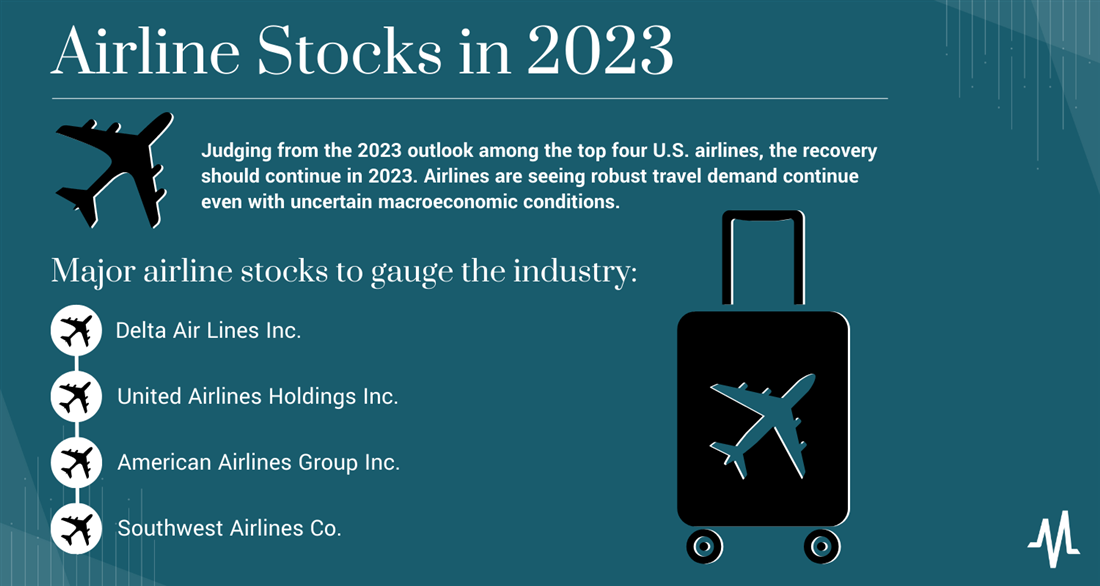Key Points
- Airline stocks continue to recover from robust travel demand as consumers shift discretionary spending from goods to services.
- Leisure travel growth is outpacing business travel in the post-pandemic era.
- New two to five-year contracts with the labor unions for its pilots, flight attendants and ground crew will cost each major airline billions more in labor costs and staffing issues.
- 5 stocks we like better than Delta Air Lines
Airlines were an epicenter industry during the pandemic, along with the travel and leisure industries. The need to stop the spread of COVID-19 warranted social distancing and stay-at-home restrictions, causing many industries to shut down as customers stayed home and workers were required to stay home.
Travel restrictions clamped down on domestic and international travel. Iconic investor Warren Buffett sold all his airline stocks during the pandemic, noting that the recovery would be long and slow. After three years, the airline industry is going through normalization with solid travel demand despite a weakening macroeconomic environment.
This article will review the airline industry and analyze the four largest airlines to help you answer the question, “Will airline stocks recover?”
Understanding the impact of the pandemic on airline stocks
Airline stocks were already showing signs of weakness during the pre-pandemic 2019. The COVID-19 pandemic was the final straw for legendary investor Warren Buffett as Berkshire Hathaway sold all his airline stocks by March 20, 2020, taking an estimated $5 billion loss. His company owns major airline stakes, including 42.5 million shares of American Airlines (10%), 58.9 million shares of Delta Air Lines (9.2%), 51.3 million shares of Southwest Airlines (10.1%) and 21.9 million shares of United Airlines (7.6%).
He noted that the recovery in the airline industry would be slow and costly. The U.S. Global Jets ETF NYSEARCA: JETS tracks the performance of airline industry stocks. Its four largest holdings include Delta Air Lines, United Airlines, Southwest Airlines and American Airlines. JETS illustrates the devastating impact that COVID-19 had on airline stocks.
The weekly candlestick chart on JETS shows it traded in a rectangle trading range oscillation between a $27.16 lower trendline and a $32.13 upper trendline in 2019. As the pandemic spread in 2020, JETS fell from the $32.13 upper trendline at the beginning of January 2020 to a low of $11.19 in March 2020, falling 65% in 10 weeks.
This mirrors the S&P 500 Index drop, representing the U.S. stock market. Bankruptcy fears plagued the airlines as they sought federal relief for the vaporization of revenues. The U.S. government negotiated a $54 billion lifeline to the U.S. airlines to save them from bankruptcy and to continue funding its workforce.
JETS rallied from the lows to a high of $28.79 by March 2021 during the post-pandemic reopening period. As COVID-19 vaccinations spread, more and more geographies and industries reopened. Social distancing and mask restrictions slowly lifted, causing a demand spike leading to supply shock as the slow reopening of factories and processing and manufacturing plants led to global supply chain disruptions. Producers were frantically trying to meet the overwhelming demand for products, which triggered a surge in inflation.
The consumer price index (CPI) is the gauge of inflation. It had risen from 2% to a 40-year high of 9.1% by June 2022. The U.S. Federal Reserve initiated aggressive interest rate hikes to curb and reverse inflation, which caused Wall Street to sell off again as invested capital got taken off the table and into savings and money market accounts, which were finally earning respectable interest rates. JETS also sold off from its $28.79 peak in March 2021 to a low of $14.77 in October 2022. It has been trying to stage a recovery since then.
The airline business had a slow recovery during the post-pandemic period. Airline stocks, however, surged with the rest of the market on the reopening. Investors wondered, “Why are airline stocks up today on no news?”
The answer is simple: the fear of missing out (FOMO) drove higher airline stocks and the stock market. Investors rushed into stocks with their stimulus checks, triggering a meme stock and special purpose acquisition company (SPAC) frenzy. JETS surged to a high of $28.79 at the peak of the post-pandemic rally in March 2021. The fundamentals didn’t surge as quickly as airline stocks.
Stocks fell in a weekly falling channel that bottomed out in October 2022. JETS has staged a rally from those lows heading into 2023 and hit a year-to-date (YTD) high of $21.24 in late January 2023. Airlines reported a return to profitability and volumes returning to pre-pandemic levels. Year-to-date, JETS has gained about 0.58% and was up about 3.85% over the last 12 months as of January 9, 2024. It has traded between $14.74 and $22.18 in the past 52 weeks.
The travel and leisure industry has been in an upside normalization, with travel restrictions having been pulled even in China. Despite uncertain macroeconomic conditions driven by high inflation, travel demand has been strong and attributed to the shift in consumer discretionary spending to services from goods.
Most major airlines had to renegotiate new contracts for their pilots, flight attendants and ground crews in 2023. Rising labor costs are a major expense partially offset by rising ticket costs. Labor contracts are usually negotiated for the next five years but two years in others. These can impact the answer to “When will airlines stocks recover?”
It’s best to research the major airline carriers to see which is suitable for you as the best airline stock to buy. Airlines are experiencing a solid recovery but are not blue chip stocks, as most have cut their dividends.
Factors influencing airline stock performance
Let’s explore the global and domestic factors that go into the complex phenomenon of airline stock performance.
- Fuel prices: Historically, when oil prices rise, airlines face increased expenses, which can eat into their profit margins. Airlines tend to benefit from lower operating costs when fuel prices decline. For example, airlines may reap higher profits during low fuel prices and see increased investor confidence, positively impacting their stock prices.
- Geopolitical events: Due to geopolitical events like political conflicts, trade disputes and terrorism, or during times of war or heightened security threats, airline stocks often decline in value due to concerns over travel safety and disruptions to international routes. But when tensions ease, or diplomatic relations improve, airline stocks may see a boost as consumers start traveling again and routes become more stable.
- Macroeconomic factors: Consumer confidence tends to be high during economic growth and stability periods. This means higher travel demand and bigger revenues for airlines. But during economic recessions or downturns, consumer confidence and discretionary spending tend to decline, with airline value following.
- Competitive landscape: The airline industry is highly competitive. Numerous carriers vie for market share. Changes in pricing strategies, marketing campaigns and route expansion can impact the performance of airlines and their stocks. For example, if Delta successfully cuts its expenses or introduces a new technology or innovative service that draws in customers, its stock may rise.
- Regulatory environment: Stricter environmental regulations may require airlines to invest in more fuel-efficient planes, increasing operating costs. On the other hand, easing restrictions on international routes or new, supportive policies for the airline industry from federal aviation authorities can have a positive effect.
Analyzing historical recovery patterns in the airline industry
Looking at the historical recovery patterns of the airline industry, we can identify common trends and lessons learned from past crises. From economic recessions to terrorist attacks and pandemics, airlines have proven their resilience and ability to rebound repeatedly.
One example is the recovery following the 9/11 terrorist attacks in 2001. Fear of flying spread across the globe. Airline stocks plummeted, and many carriers faced financial losses. However, the industry recovered through government support, enhanced security measures and a gradual return of consumer confidence.
It took several years, but the airline industry eventually saw a resurgence in stock prices.
Similarly, consumer spending declined during the 2008 global financial crisis, and travel demand plummeted. Many carriers were forced to cut costs, lay off employees and restructure. But with government stimulus packages and strategic measures by airline executives, the industry slowly but steadily bounced back. By focusing on cost efficiency, optimizing routes and offering competitive fares, they attracted passengers and regained profitability.
Finally, the COVID-19 pandemic presented a once-in-a-lifetime crisis. Travel restrictions, lockdowns and a sharp decline in demand brought the airline industry to its knees. Airline stocks dropped, and many carriers faced the threat of bankruptcy.
However, vaccinations soon became widely available, and governments started easing travel restrictions. People were eager to explore the world again, and travel demand slowly rebounded.
Airlines implemented strict health and safety protocols to reassure passengers. These included mask mandates, enhanced cleaning procedures, and improved air filtration systems. As confidence in air travel grew, airlines began increasing their flight schedules and reopening suspended routes. Stock prices gradually started ticking upward again, giving a glimmer of hope to consumers and investors alike.
Current market trends and investor sentiment
Despite the challenges the airline industry has faced in recent years, there is growing optimism about how the airlines will fare in the coming years.
Among investors, there’s a cautious but positive outlook. For example, American Airlines Group Inc. NASDAQ: AAL offers winter getaway packages for around $300. The second-largest airline by total revenue has seen a 30% share increase since October. In March, the Amex Airline Index dropped 40% due to a drop in demand and rising costs, but the International Air Transport Association predicts record profits for the industry in 2024. With a 17% market share, American could be one of the biggest winners.
However, the pandemic dealt a heavy blow to the passenger airline industry, causing many shareholders of airlines such as American, Delta, Southwest and United to sell their stocks after initially investing in them as a post-pandemic reopening play. Nevertheless, things are starting to look up as we enter 2024. With expected decreases in cost inflation and consistent high fare prices, airlines are likely gearing up for a period of growth.
Government support and policies affecting airline stocks
Government support and policies have been pivotal in recovering the best-performing airline stocks throughout history. In the aftermath of the 9/11 terrorist attacks or the global financial crisis of 2008, for instance, governments intervened to prevent the industry’s collapse and stimulate its revival. These measures have had both short-term and long-term effects on airline stocks.
After 9/11, fear and uncertainty gripped the world, leading to a sharp decline in air travel demand and causing airline stocks to plummet. However, governments recognized the importance of a strong and stable airline industry for economic and national security. So, they provided financial assistance to struggling carriers. Bailout packages alleviated the most immediate financial pressures, allowing airlines to continue operating and retain workers. These funds helped cover operating costs, including fuel expenses and employee salaries and increased operating cash flow, even when revenues decreased.
But consumers won’t fly if they feel unsafe. So, heightened airport security protocols and stringent screening processes addressed air travel safety concerns. These measures, combined with financial support, gradually restored consumer confidence and contributed to the recovery of airline stocks.
Similarly, during the global financial crisis, governments again recognized the importance of the airline industry in stimulating economic growth. Stimulus packages provided liquidity and supported struggling carriers’ balance sheets. These funds allowed airlines to weather the storm, maintain operations, and preserve jobs. Additionally, the government enacted policies to promote consumer spending and boost travel demand. This included tax incentives for travel expenses and marketing campaigns to encourage domestic and international tourism.
The government support and policies implemented during these crises significantly impacted airline stocks.
Innovations and adaptations in the airline industry
It’s remarkable how far airline and aerospace technology has advanced in the century since its invention. Tech advancements have played a crucial role in revolutionizing the way airlines operate. They’ve enhanced efficiency, sustainability and customer experience.
Contactless technologies have allowed passengers to check in, pass through security and board their flights using smartphones or other personal devices.
In-flight entertainment systems also transformed. Gone were the days of shared screens and limited options. Airlines now offer individual touchscreens where you can choose movies, TV shows and interactive games. Passengers can customize their entertainment experience.
Airlines are also adopting newer planes that consume less fuel, reducing costs and environmental impact. Far from burning fuel capriciously, eco-friendly initiatives target environmentally conscious passengers and position airlines as leaders in sustainability.
The rise of low-cost carriers like Spirit Airlines has made air travel more accessible to a wider range of passengers who want no-frills service to their destinations. Of course, they’re not for everyone, but they’ve forced larger carriers to innovate to stay ahead.
Airline stocks in 2024
Here’s a profile of four major and arguably best airline stocks to gauge the industry.
Delta Air Lines Inc.
Delta Air Lines Inc. NYSE: DAL has improved its operations since the pandemic, emerging as one of the most efficient airlines in the nation. Delta will be the largest U.S. airline in 2024 regarding fleet size, revenue and market cap.
Operational costs rose due to fuel and maintenance increases despite a 9.4% decrease in average airline ticket prices. The company maintains its status as the most on-time airline, with an 88% on-time arrival rate in 2023. The company uses a hub-and-spoke flight network serving 200 million customers annually. Its Q4 2023 generated $2 billion in operating cash flow.
2024 outlook
In 2024, the company expects to generate $6 to $7 per share in earnings. The company claims that consumer demand is way ahead of pre-pandemic levels. DAL stock has a one-year performance of up 0.55% with no dividend. Delta Air Lines analyst ratings and price targets are on MarketBeat.
United Airlines Holdings Inc.
United Airlines Holdings Inc. NYSE: UAL last reported its earnings on October 18, 2023. It announced that total revenue increased by 12.5% year-over-year, achieving a new record high. UAL experienced consistently strong demand for domestic flights during this period, leading to a 9% growth in revenue compared to the previous quarter.
The company reported a high demand for premium products, which resulted in a 20% increase in revenue from those products. MileagePlus, the company’s loyalty program, saw a significant increase in new member enrollments this quarter and has been experiencing steady growth over the past few years from customers seeking available seat mile award tickets. This quarter set a new record for enrollments and almost doubled the number of new members during the same period compared to five years ago.
2024 outlook
Small business volume is back to pre-pandemic levels. Bookings will continue to be strong. The company expects a strong and steady international summer travel season in 2024. However, earnings for United Airlines should decrease by 0.72% in 2024, from $9.68 to $9.61 per share. UAL stock has fallen 22.30% with no dividend. Check out United Airlines analyst ratings and price targets on MarketBeat.
American Airlines Group Inc.
American Airlines Group Inc. is the second largest airline in the U.S., with a fleet of more than 900 airplanes and over 350 destinations in more than 50 countries. The company expects robust travel demand to continue through 2024.
American Airlines posted a third-quarter loss on October 19 due to higher fuel prices and a lowered profit forecast for the year. For the fourth quarter, American estimates are breaking even. Total revenue was $13.48 billion, beating expectations of $13.52 billion.
While travel has increased, fares have dropped compared to last year. The company reported a loss of $545 million for the third quarter, down from a profit of $483 million in the same period last year (adjusted earnings: $263 million). This was America’s first loss since the first quarter of 2022. They delivered 50 new airplanes in 2023 to modernize their fleet and improve efficiency.
2024 outlook
The airline expects to earn between $2.25 and $2.50 per share, with a full-year operating margin of 7%. Management says international travel will be strong in 2024, and robust travel demand will continue. AAL stock has a one-year performance of negative 22.6% with no dividend. Check out American Airlines analyst ratings and price targets on MarketBeat.
Southwest Airlines Co.
Low-cost airline Southwest Airlines Co. NYSE: LUV is about efficiency and keeping costs down to support low fares. The company has grown from a small airline delivering mail in Texas to the nation’s fourth-largest carrier, with over 790 planes serving more than 100 destinations, mainly in the U.S. and Mexico.
Southwest suffered a significant blow when its computer system crashed in December 2022 during its peak holiday season. The flight scheduling system crash was a significant disruption, causing the airline to cancel over 2,000 flights. Financial damages range from $725 million to $825 million in refunds, compensation and system upgrades.
It also damaged its reputation and launched an investigation by the Federal Aviation Administration (FAA) and Transportation Security Administration (TSA). System disruptions caused a $380 million impact in Q1 2023, turning earnings negative. The airline’s net income in the second quarter of that year fell to $1.08 a share, down 10% from $760 million, or $1.20 per share, from the same quarter in 2022.
By October 26, 2023, the company had reported a net profit of $193 million, or 31 cents per diluted share in Q3 2023. Excluding special circumstances, the company’s net income was $240 million, or $0.38 per diluted share. Southwest Airlines achieved its highest Q3 operating revenue of $6.5 billion, setting a new record for the company.
2024 Outlook
Earnings for Southwest Airlines will likely grow by 25.55% in the coming year, from $1.37 to $1.72 per share.
Southwest has scaled back its growth plans for the upcoming year in response to decreased travel demand. The company also acknowledged its challenges due to inflation and increased labor costs, driving up expenses.
LUV stock has a one-year performance of down (22.87%) and pays a 2.52% dividend yield. Check out Southwest Airlines analyst ratings and price targets on MarketBeat.
Outlook for the airline industry
The great travel recovery should continue in 2024. Airlines are seeing robust travel demand continue even with uncertain macroeconomic conditions.
Consumers have pulled back their discretionary spending and shifted from spending on products to services, which fuels the robust demand for travel and leisure. Although fuel costs and labor are rising, the recovery in airline stocks should continue throughout 2024 as fundamentals improve. However, consumer spending behavior can be fickle and turn on a dime, so proceed with caution.
FAQs
Here are some answers to your frequently asked questions.
Will airline stocks recover in 2024?
The airline industry looks to continue its recovery in 2024 based on robust travel demand. Many airlines expect solid international travel. Consumers have shifted their spending to services rather than goods and products. Airline stocks should but not always follow the improvements in fundamentals as sentiment is a key mover of stocks.
What is the outlook for the airlines in 2024?
Airlines should earn non-GAAP profits in 2024 as business recovers to and above pre-pandemic levels. Airlines expect a higher average fuel price and labor costs due to negotiations with respective labor unions. They’re also upgrading their aircraft fleets to stay efficient and competitive in the coming years.
Why are airline stocks down?
Like most stocks, airline stocks recovered too fast in 2021, causing a mini-bubble burst when the U.S. Federal Reserve started its aggressive monetary tightening policy, raising interest rates to combat inflation. The U.S. consumer price index (CPI) is the inflation gauge, and it hit a 40-year high of 9.1% in June 2022.
After the post-pandemic sell-off in 2022, stocks attempt to rally in 2023 and 2024 as interest rate hikes conclude and the travel demand continues.
Before you consider Delta Air Lines, you’ll want to hear this.
MarketBeat keeps track of Wall Street’s top-rated and best performing research analysts and the stocks they recommend to their clients on a daily basis. MarketBeat has identified the five stocks that top analysts are quietly whispering to their clients to buy now before the broader market catches on… and Delta Air Lines wasn’t on the list.
While Delta Air Lines currently has a “Buy” rating among analysts, top-rated analysts believe these five stocks are better buys.
View The Five Stocks Here

As the AI market heats up, investors who have a vision for artificial intelligence have the potential to see real returns. Learn about the industry as a whole as well as seven companies that are getting work done with the power of AI.
Get This Free Report


